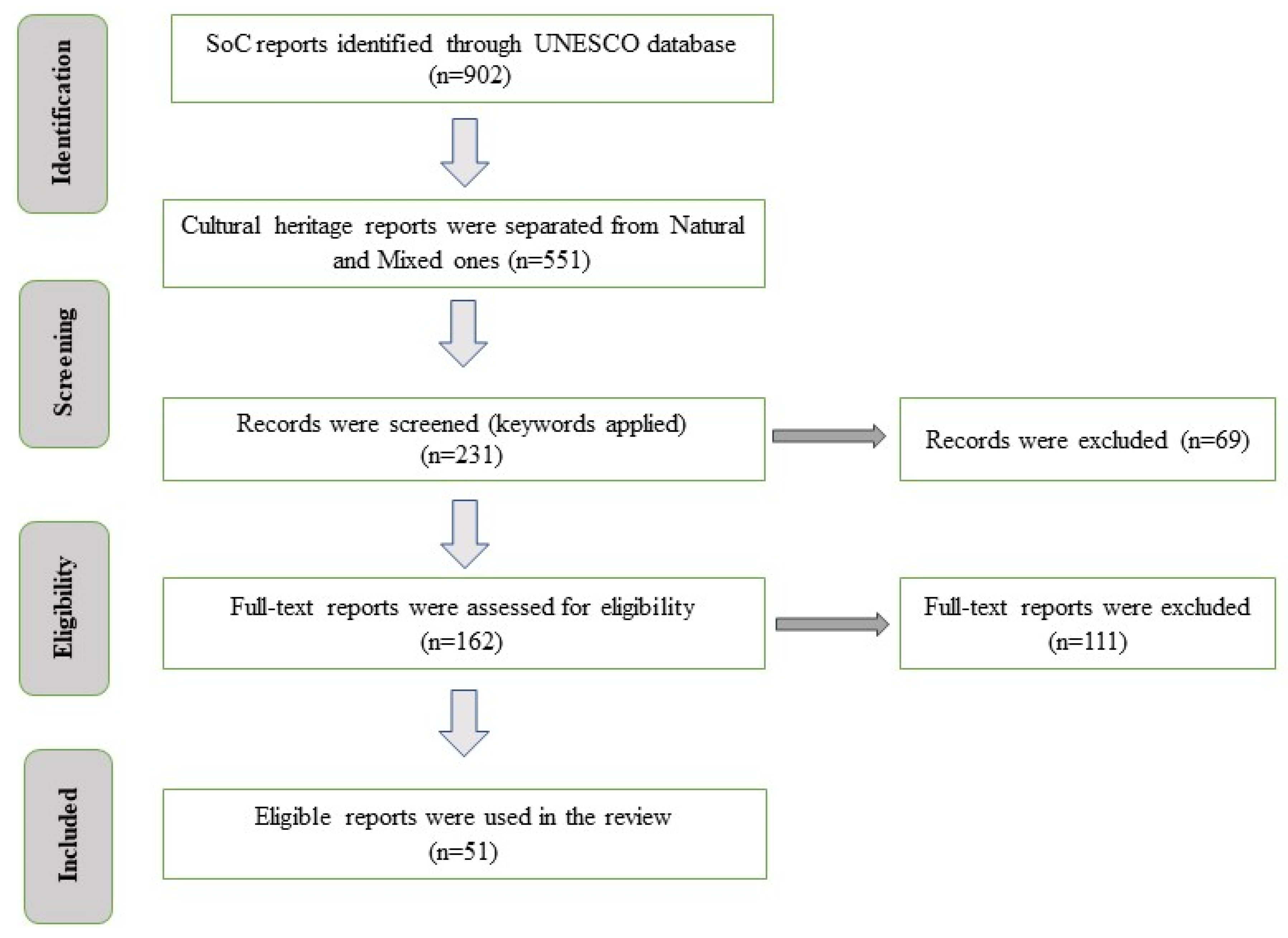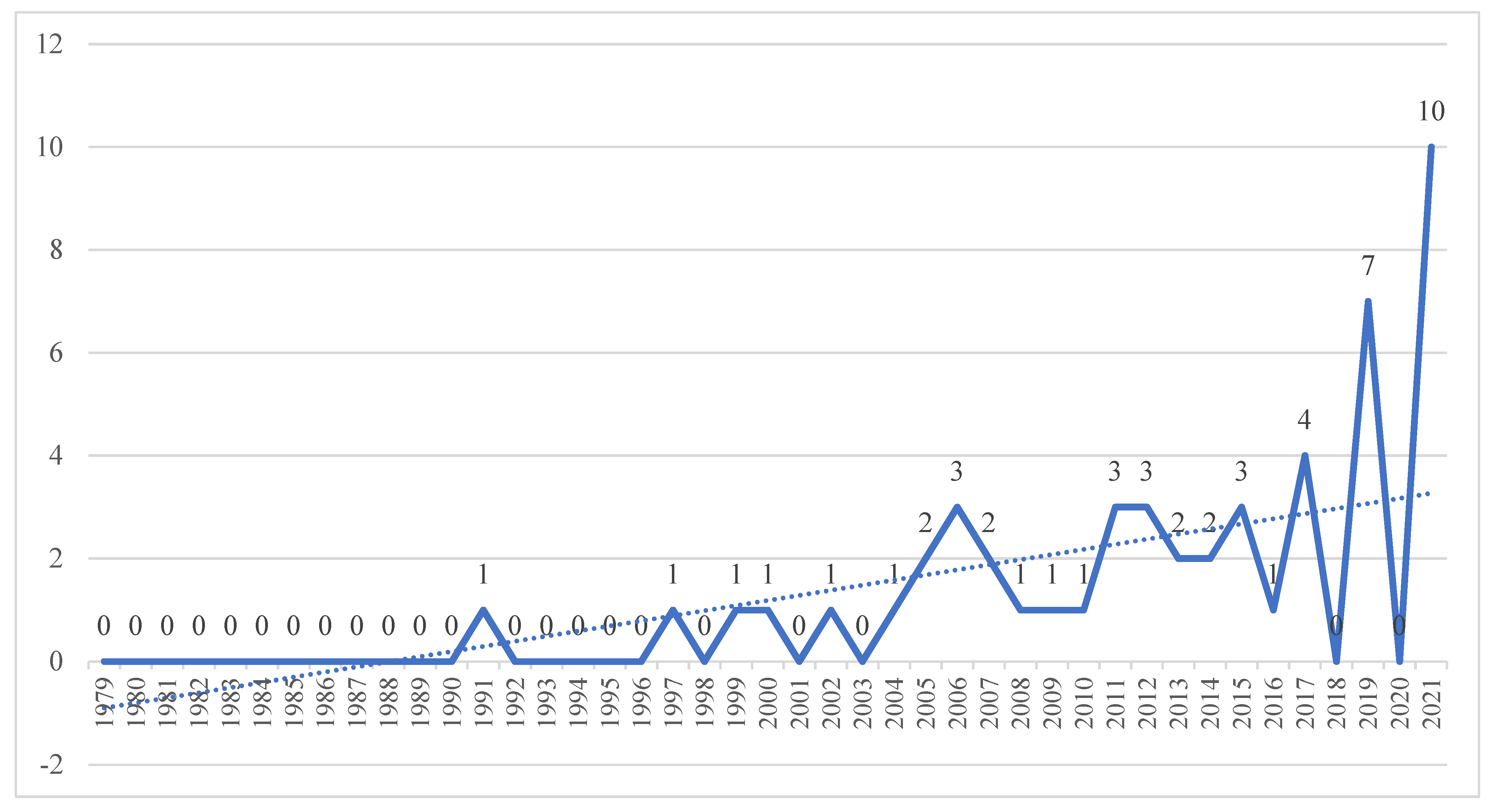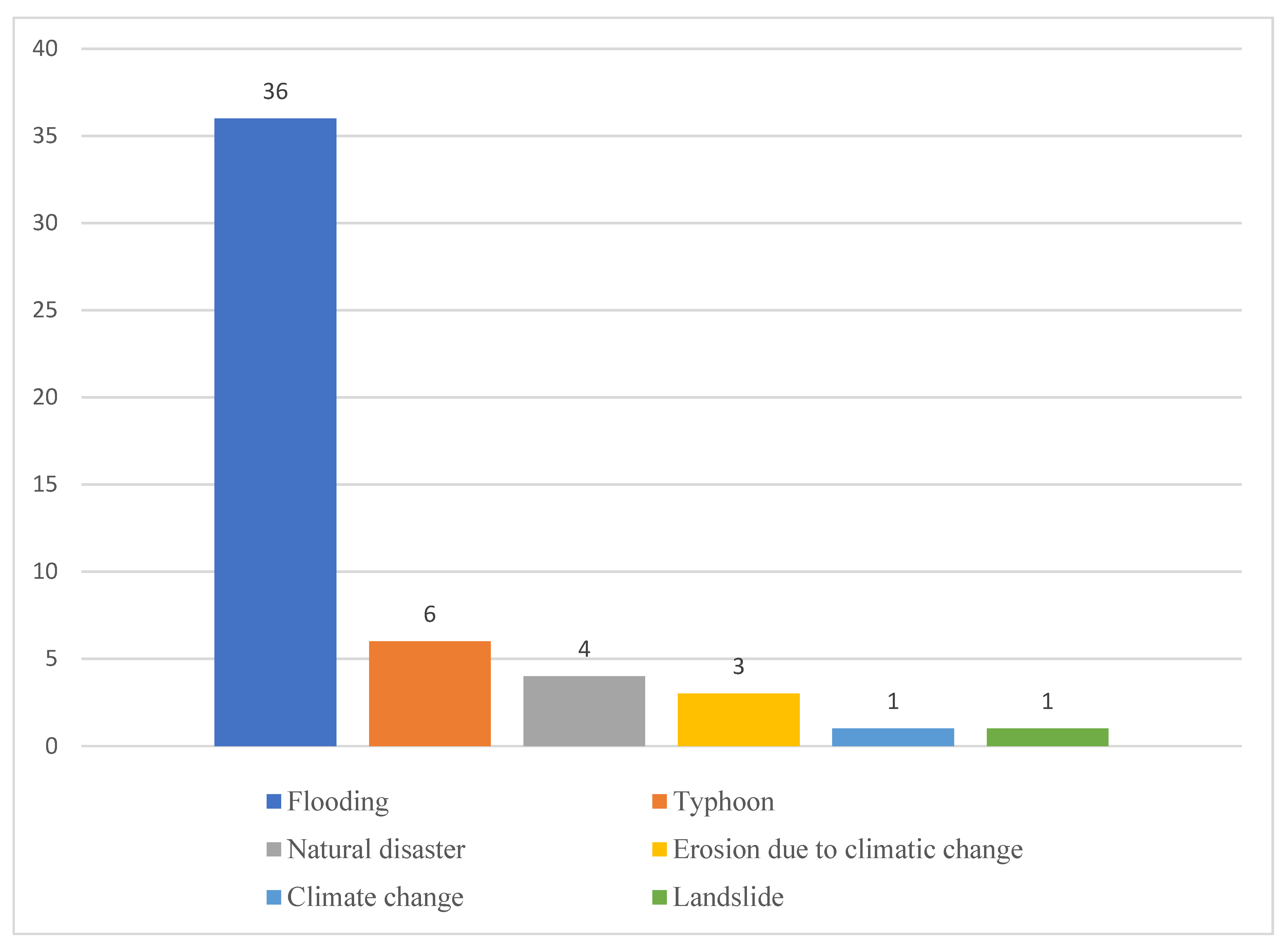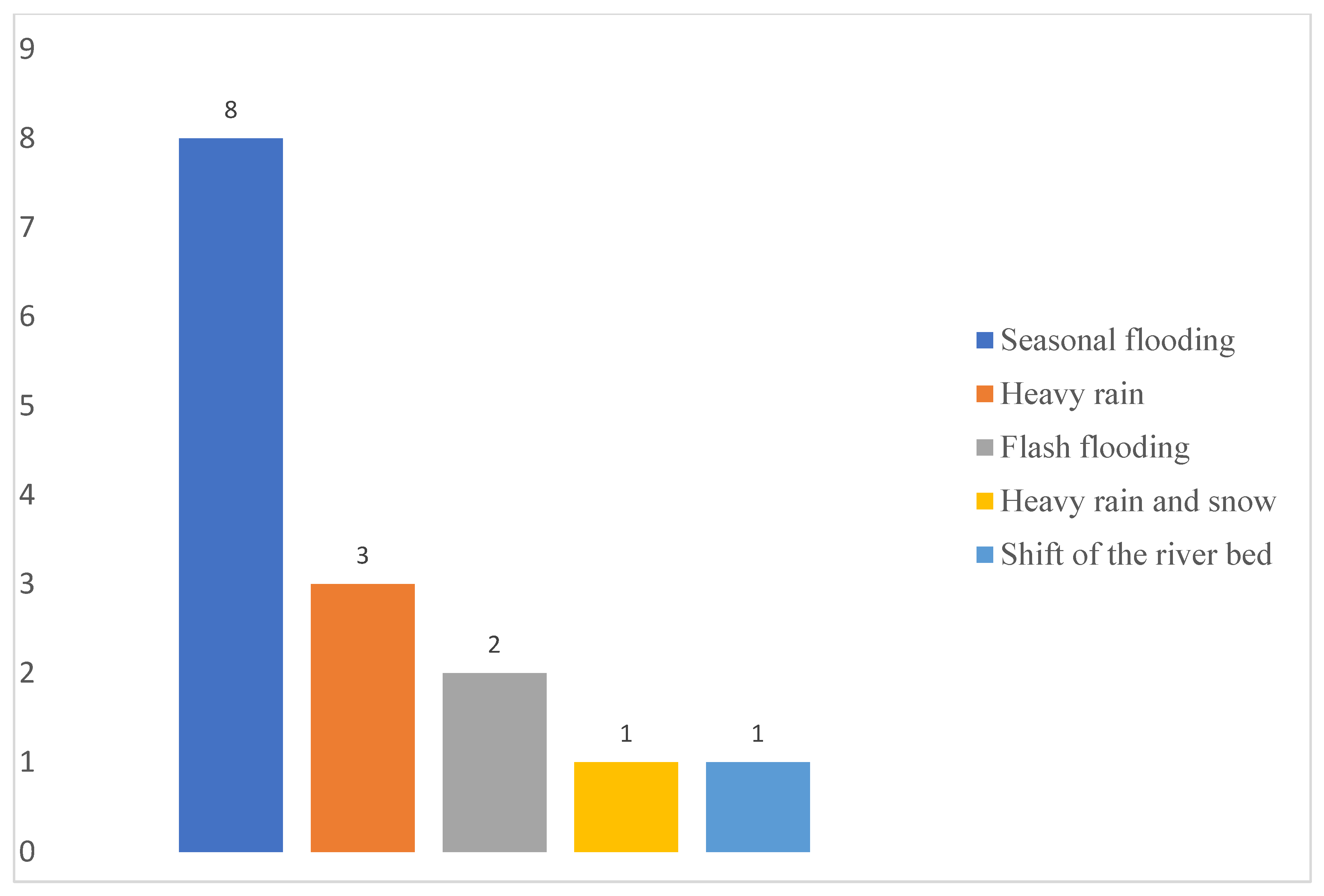Climate Change Impacts on UNESCO World Heritage-Listed Cultural Properties in the Asia–Pacific Region: A Systematic Review of State of Conservation Reports, 1979–2021
Abstract
:1. Introduction
2. UNESCO State of Conservation Information System
“Each State Party to this Convention recognizes that the duty of ensuring the identification, protection, conservation, presentation and transmission to future generations of the cultural and natural heritage…situated on its territory, belongs primarily to that State. It will do all it can to this end, to the utmost of its own resources and, where appropriate, with any international assistance and co-operation, in particular, financial, artistic, scientific and technical, which it may be able to obtain.” [9]
3. Research Materials and Method
3.1. Data Collection
3.2. Material Analysis
4. Research Findings
4.1. General Characteristics
4.1.1. Year of Reports
4.1.2. Geographic Distribution
4.1.3. Types of Climate Change Hazards
4.2. Primary Focus
4.2.1. Climate Change Impacts
4.2.2. Types of Response
4.2.3. Challenges
4.2.4. Recommendations
5. Discussion
5.1. The Unnoticed Properties
The Missing Pacific
The harbour’s facilities are less intact: most of the jetties have been washed away. … The island’s main road, which is still the high street in Levuka, hugs the coastline where it is often inundated when the sea wall is breached by king tides and storms, flooding from upstream, or disrupted by repairs to bridges which cross the numerous creeks. The landscape of the flat lowlands is mostly cleared of vegetation and scored with open channels that don’t always deal adequately with extreme rain conditions and often overflow. … Following Cyclone Winston [in 2016], many home and business owners in Levuka delayed rebuilding, hoping for UN-designated funds to cover the restoration of heritage buildings as they struggled to meet the demands of reconstruction guidelines. During our visit, a full year later, many of these rebuilding projects continued to languish. Conservation does not happen in a vacuum, and Cyclone Winston is likely to be an early harbinger of increasing climate risk to which Levuka and Ovalau must adapt, as Levuka’s historic Beach Street is only a few metres above sea level and floods easily. Whilst the UNESCO evaluation document acknowledges that vulnerability is likely to increase with climate change, what this changing context means for Levuka as a heritage site has not been evaluated. The UNESCO application file lists ‘coastal protection and sea buffer boosted’ [66], (p. 122) as the long-term strategy to cope with climate change and sea level rise. This response is underdeveloped and fails to address the confluence of runoff with rising seas or increasing cyclone risk. … [I]n Levuka when storm surge and sea level rise threaten the integrity of the town’s built fabric, the conservation response is to provide immediate protection by raising the level of the sea wall. Ironically this simply increases vulnerability. The wall makes the immediate threat disappear, life goes on as before, people become complacent and have no reason to develop the adaptive strategies that might protect them in the future should the wall fail, or a combination of flooding and storm surge inundate the town.
6. Conclusions
Supplementary Materials
Author Contributions
Funding
Institutional Review Board Statement
Informed Consent Statement
Data Availability Statement
Conflicts of Interest
References
- UNESCO. Yin Xu. 2006. Available online: https://whc.unesco.org/en/list/1114/ (accessed on 10 August 2023).
- Wu, S. Ancient Chinese Sites Hit by Flash Floods This Summer. 2021. Available online: https://www.theartnewspaper.com/2021/09/07/ancient-chinese-sites-hit-by-flash-floods-this-summer (accessed on 5 August 2023).
- UNESCO. Longmen Grottoes. 2000. Available online: https://whc.unesco.org/en/list/1003/ (accessed on 1 August 2023).
- Reuters. Climate Change Menaces China’s Ancient Heritage Sites. 2023. Available online: https://www.nbcnews.com/news/asia/climate-change-menaces-chinas-ancient-heritage-sites-rcna94808 (accessed on 22 August 2023).
- Greenpeace East Asia. Ancient Buddhist Art in Peril as Extreme Rainfall Hits China’s Silk Road. 2023. Available online: https://www.greenpeace.org/eastasia/press/8102/ancient-buddhist-art-in-peril-as-extreme-rainfall-hits-chinas-silk-road/ (accessed on 20 August 2023).
- UNESCO. List of Factors Affecting the Properties. 2008. Available online: https://whc.unesco.org/en/factors (accessed on 20 June 2023).
- Marsh, H.; Smith, A.; Terrill, G. World Heritage and the challenge of climate change: A reform agenda. Int. J. Herit. Stud. 2023, 29, 39–48. [Google Scholar] [CrossRef]
- Kormos, C.F.; Badman, T.; Jaeger, T.; Bertzky, B.; van Merm, R.; Osipova, E.; Shi, Y.; Larsen, P.B. World Heritage, Wilderness, and Large Landscapes and Seascapes; IUCN: Gland, Switzerland, 2017. [Google Scholar]
- UNESCO. Convention Concerning the Protection of the World Cultural and Natural Heritage. In UNESCO World Heritage Centre—Convention Concerning the Protection of the World Cultural and Natural Heritage; UNESCO: Paris, France, 1972; Available online: https://whc.unesco.org/archive/convention-en.pdf (accessed on 1 June 2023).
- Reimann, L.; Vafeidis, A.T.; Brown, S.; Hinkel, J.; Tol, R.S. Mediterranean UNESCO World Heritage at risk from coastal flooding and erosion due to sea-level rise. Nat. Commun. 2018, 9, 4161. [Google Scholar] [CrossRef] [PubMed]
- Nguyen, K.N.; Baker, S. Climate Change and UNESCO World Heritage-Listed Cultural Properties: A Systematic Review, 2008–2021. Heritage 2023, 6, 2394–2420. [Google Scholar] [CrossRef]
- UNESCO. Climate Change. 2021. Available online: https://whc.unesco.org/en/review/100/ (accessed on 15 June 2023).
- UNFCCC. Climate Change: Impacts, Vulnerabilities and Adaptation in Developing Countries. 2007. Available online: https://unfccc.int/resource/docs/publications/impacts.pdf (accessed on 2 June 2023).
- Colette, A. Climate Change and World Heritage. Report on Predicting and Managing the Impacts of Climate Change on World Heritage and Strategy to Assist States Parties to Implement Appropriate Management Responses; UNESCO World Heritage Centre: Paris, France, 2007. [Google Scholar]
- Aktürk, G. A systematic overview of the barriers to building climate adaptation of cultural and natural heritage sites in polar regions. Environ. Sci. Policy 2022, 136, 19–32. [Google Scholar] [CrossRef]
- Dai, T.; Zheng, X.; Yang, J. A systematic review of studies at the intersection of urban climate and historical urban landscape. Environ. Impact Assess. Rev. 2022, 97, 106894. [Google Scholar] [CrossRef]
- Fatorić, S.; Seekamp, E. Are cultural heritage and resources threatened by climate change? A systematic literature review. Clim. Chang. 2017, 142, 227–254. [Google Scholar] [CrossRef]
- Orr, S.A.; Richards, J.; Fatorić, S. Climate change and cultural heritage: A systematic literature review (2016–2020). Hist. Environ. Policy Pract. 2021, 12, 434–477. [Google Scholar] [CrossRef]
- Quesada-Ganuza, L.; Garmendia, L.; Roji, E.; Gandini, A. Do we know how urban heritage is being endangered by climate change? A systematic and critical review. Int. J. Disaster Risk Reduct. 2021, 65, 102551. [Google Scholar] [CrossRef]
- Alberani, V.; Pietrangeli, P.D.C.; Mazza, A.M. The use of grey literature in health sciences: A preliminary survey. Bull. Med. Libr. Assoc. 1990, 78, 358–363. [Google Scholar]
- Spires, M.; Shackleton, S.; Cundill, G. Barriers to implementing planned community-based adaptation in developing countries: A systematic literature review. Clim. Dev. 2014, 6, 277–287. [Google Scholar] [CrossRef]
- McNamara, K.E.; Clissold, R.; Piggott-McKellar, A.; Buggy, L.; Azfa, A. What is shaping vulnerability to climate change? The case of Laamu Atoll, Maldives. Isl. Stud. J. 2019, 14, 81–100. [Google Scholar] [CrossRef]
- Guzman, P.; Pereira Roders, A.R.; Colenbrander, B. Impacts of common urban development factors on cultural conservation in world heritage cities: An indicators-based analysis. Sustainability 2018, 10, 853. [Google Scholar] [CrossRef]
- UNESCO. Operational Guidelines for the Implementation of the World Heritage Convention; UNESCO: Paris, France, 2021. [Google Scholar]
- Meskell, L. States of conservation: Protection, politics, and pacting within UNESCO’s World Heritage Committee. Anthropol. Q. 2014, 87, 217–243. [Google Scholar] [CrossRef]
- Meskell, L.; Liuzza, C.; Bertacchini, E.; Saccone, D. Multilateralism and UNESCO World Heritage: Decision-making, States Parties and political processes. Int. J. Herit. Stud. 2015, 21, 423–440. [Google Scholar] [CrossRef]
- Guzman, P.; Fatorić, S.; Ishizawa, M. Monitoring climate change in world heritage properties: Evaluating landscape-based approach in the state of conservation system. Climate 2020, 8, 39. [Google Scholar] [CrossRef]
- Cantillon, Z.; Baker, S. Ketch Yorlye Daun Paradise: Sense of place, heritage and belonging in Norfolk Island’s Kingston and Arthur’s Vale Historic Area. Thesis Elev. 2022, 172, 93–113. [Google Scholar] [CrossRef]
- Nguyen, K.N. Climate change and heritage preservation: A case study of the Complex of Hue Monuments. In Cities and Climate Change; Martinus, M., Qiu, J., Seah, S., Eds.; ISEAS Publishing: Singapore, 2023; pp. 44–58. [Google Scholar]
- Young, C. Understanding management in a world heritage context: Key current issues in Europe. Hist. Environ. Policy Pract. 2016, 7, 189–201. [Google Scholar] [CrossRef]
- UNESCO. “Periodic Reporting”. 2023. Available online: http://whc.unesco.org/en/periodicreporting/ (accessed on 1 August 2023).
- UNESCO. Strengthening the Effectiveness of the World Heritage Reactive Monitoring Process; UNESCO: Paris, France, 2019. [Google Scholar]
- Turner, M.; Pereira, A.; Patry, M. Revealing the Level of Tension between Cultural Heritage and Development in World Heritage Cities (Oszacowanie zakresu konfliktów występujących pomiędzy ochroną dziedzictwa kulturowego a rozwojem w miastach z Listy Światowego Dziedzictwa). Probl. Sustain. Dev. 2012, 7, 23–31. [Google Scholar]
- UNESCO. State of Conservation Information System (SOC). 2023. Available online: https://whc.unesco.org/en/soc/ (accessed on 2 June 2023).
- Veillon, R. State of Conservation of World Heritage Properties. A Statistical Analysis (1979–2013); UNESCO World Heritage Centre: Paris, France, 2014. [Google Scholar]
- UNESCO. Analytical Summary of the State of Conservation of World Heritage Properties; Decision 32 COM 7B.129; UNESCO: Paris, France, 2009. [Google Scholar]
- UNESCO. New World Heritage State of Conservation Information System Accessible to Public. 2012. Available online: https://whc.unesco.org/en/news/962 (accessed on 20 August 2023).
- De Roo, B.; Bourgeois, J.; De Maeyer, P. Conservation of past times: Data models for ensuring the future of our heritage. In Built Heritage: Monitoring Conservation Management; Toniolo, L., Boriani, M., Guidi, G., Eds.; Springer International Publishing: Cham, Switzerland, 2015; pp. 982–988. [Google Scholar]
- Chechi, A. The Cultural Dimension of Climate Change: Some Remarks on the Interface between Cultural Heritage and Climate Change Law. In Climate Change as a Threat to Peace: Impacts on Cultural Heritage and Cultural Diversity; von Schorlemer, S., Maus, S., Eds.; Peter Lang Academic Research: Frankfurt, Germany, 2014; pp. 161–197. [Google Scholar]
- Collins, J.A.; Fauser, B.C. Balancing the strengths of systematic and narrative reviews. Hum. Reprod. Update 2005, 11, 103–104. [Google Scholar] [CrossRef]
- Pickering, C.; Byrne, J. The benefits of publishing systematic quantitative literature reviews for PhD candidates and other early-career researchers. High. Educ. Res. Dev. 2014, 33, 534–548. [Google Scholar] [CrossRef]
- Xiao, Y.; Watson, M. Guidance on conducting a systematic literature review. J. Plan. Educ. Res. 2019, 39, 93–112. [Google Scholar] [CrossRef]
- Petticrew, M.; Roberts, H. Systematic Reviews in the Social Sciences: A Practical Guide; John Wiley: Oxford, UK, 2006. [Google Scholar]
- Page, M.J.; McKenzie, J.E.; Bossuyt, P.M.; Boutron, I.; Hoffmann, T.C.; Mulrow, C.D.; Shamseer, L.; Tetzlaff, J.M.; Akl, E.A.; Brennan, S.E.; et al. The PRISMA 2020 statement: An updated guideline for reporting systematic reviews. BMJ 2021, 372, n71. [Google Scholar] [CrossRef] [PubMed]
- Moher, D.; Liberati, A.; Tetzlaff, J.; Altman, D.G. Preferred reporting items for systematic reviews and meta-analyses: The PRISMA statement. Ann. Intern. Med. 2009, 151, 264–269. [Google Scholar] [CrossRef]
- World Heritage Committee. State of Conservation Report. Borobudur Temple Compounds. 2003. Available online: https://whc.unesco.org/en/soc/2739 (accessed on 7 August 2023).
- UNESCO. Rice Terraces of the Philippine Cordilleras. 2012. Available online: https://whc.unesco.org/en/soc/149/ (accessed on 2 August 2023).
- UNESCO. Nan Madol: Ceremonial Centre of Eastern Micronesia. 2019. Available online: https://whc.unesco.org/en/soc/3877 (accessed on 2 August 2023).
- UNESCO. Minaret and Archaeological Remains of Jam. 2015. Available online: https://whc.unesco.org/en/soc/3208 (accessed on 1 August 2023).
- World Heritage Committee. State of Conservation Report. Complex of Hue Monuments. 2006. Available online: https://whc.unesco.org/en/soc/1191/ (accessed on 7 August 2023).
- Nishimura, T.; Kajitani, Y.; Tatano, H. Damage assessment in tourism caused by an earthquake disaster. J. Integr. Disaster Risk Manag. 2013, 3, 56–74. [Google Scholar] [CrossRef]
- Brimblecombe, P.; Hayashi, M.; Futagami, Y. Mapping climate change, natural hazards and Tokyo’s built heritage. Atmosphere 2020, 11, 680. [Google Scholar] [CrossRef]
- Rosselló, J.; Becken, S.; Santana-Gallego, M. The effects of natural disasters on international tourism: A global analysis. Tour. Manag. 2020, 79, 104080. [Google Scholar] [CrossRef]
- Tsai, H.T.; Tseng, C.J.; Tzeng, S.Y.; Wu, T.J.; Day, J.D. The impacts of natural hazards on Taiwan’s tourism industry. Nat. Hazards 2012, 62, 83–91. [Google Scholar] [CrossRef]
- UNESCO. Mountain Railways of India. 2023. Available online: https://whc.unesco.org/en/list/944/ (accessed on 28 August 2023).
- Pradesh, H. UNESCO World Heritage Site Kalka-Shimla Railway Line Affected by Heavy Rain and Floods. 2023. Available online: https://timesofindia.indiatimes.com/travel/travel-news/unesco-world-heritage-site-kalka-shimla-railway-line-affected-by-heavy-rain-and-floods/articleshow/102828153.cms (accessed on 10 August 2023).
- Kumar, A. UNESCO World Heritage Shimla-Kalka Railway Line Hit by Heavy Rains, Landslides. 2023. Available online: https://www.indianarrative.com/india-news/unesco-world-heritage-shimla-kalka-railway-line-hit-by-heavy-rains-landslides-150139.html (accessed on 5 August 2023).
- IPCC. Climate Change 2022: Impacts, Adaptation and Vulnerability. 2022. Available online: https://www.ipcc.ch/report/ar6/wg2/ (accessed on 5 August 2023).
- Samuels, K.L.; Platts, E.J. Global climate change and UNESCO World Heritage. Int. J. Cult. Prop. 2022, 29, 409–432. [Google Scholar] [CrossRef]
- World Heritage Committee. State of Conservation Report. Complex of Hue Monuments. 1999. Available online: https://whc.unesco.org/en/soc/2352 (accessed on 5 August 2023).
- Bui, H.T.; Le, T.A. Case Study Vietnam: Climate change impacts on UNESCO World Heritage-the case of Hoi An Ancient Town. In Global Climate Change and Coastal Tourism: Recognizing Problems, Managing Solutions and Future Expectations; Jones, A.L., Phillips, M., Eds.; CABI: Wallingford, UK, 2017; pp. 191–199. [Google Scholar]
- Collyer, F.M. Global patterns in the publishing of academic knowledge: Global North, global South. Curr. Sociol. 2018, 66, 56–73. [Google Scholar] [CrossRef]
- Mcleod, E.; Bruton-Adams, M.; Förster, J.; Franco, C.; Gaines, G.; Gorong, B.; James, R.; Posing-Kulwaum, G.; Tara, M.; Terk, E. Lessons from the Pacific Islands–adapting to climate change by supporting social and ecological resilience. Front. Mar. Sci. 2019, 6, 289. [Google Scholar] [CrossRef]
- Wolf, F.; Filho, W.L.; Singh, P.; Scherle, N.; Reiser, D.; Telesford, J.; Miljković, I.B.; Havea, P.H.; Li, C.; Surroop, D.; et al. Influences of climate change on tourism development in small pacific island states. Sustainability 2021, 13, 4223. [Google Scholar] [CrossRef]
- Allan, P.; Yarina, E.; Bryant, M. Landscape as middle ground: A resilience approach to conservation and promotion of UNESCO World Heritage Site, Levuka, Fiji. Hist. Environ. 2019, 31, 106–116. [Google Scholar]
- UNESCO World Heritage Nomination. ‘Levuka Management Plan’. 2012. Available online: https://whc.unesco.org/uploads/nominations/1399.pdf (accessed on 25 August 2023).




| States Parties | Cultural Properties | Year of Inscription | Year of SoC Report | Hazards | World Heritage in Danger Listing |
|---|---|---|---|---|---|
| Afghanistan | Minaret and Archaeological Remains of Jam | 2002 | 2004, 2006, 2008, 2009, 2012, 2013, 2014, 2017, 2019, 2021 | Typhoon, Flooding | 2002–present |
| Cambodia | Angkor | 1992 | 2021 | Flooding | |
| China | Ancient Building Complex in the Wudang Mountains | 1994 | 2014 | Flooding | |
| The Great Wall | 1987 | 2019 | Flooding | ||
| India | Group of Monuments at Hampi | 1986 | 2015 | Flooding | |
| Mountain Railways of India | 1999 | 2021 | Landslide | ||
| Iran | Susa | 2015 | 2017, 2021 | Erosion due to climatic change | |
| Meidan Emam, Esfahan | 1979 | 2019 | Natural hazard | ||
| Sassanid Archaeological Landscape of Fars Region | 2018 | 2021 | Natural hazard | ||
| The Persian Qanat | 2016 | 2021 | Natural hazard | ||
| Japan | Gusuku Sites and Related Properties of the Kingdom of Ryukyu | 2000 | 2021 | Typhoon | |
| Laos | Town of Luang Prabang | 1995 | 2021 | Flooding | |
| Micronesia | Nan Madol: Ceremonial Centre of Eastern Micronesia | 2016 | 2019 | Climate change | 2016–present |
| Pakistan | Archaeological Ruins at Moenjodaro | 1980 | 1991, 2007, 2011 | Flooding | |
| Historical Monuments at Makli, Thatta | 1981 | 2011, 2012, 2013, 2015, 2016, 2017, 2019, 2021 | Flooding | ||
| Philippines | Rice Terraces of the Philippine Cordilleras | 1995 | 2002, 2005, 2006, 2010, 2011, 2012, 2021 | Erosion due to climatic change, Typhoon, Flooding | 2001–2012 |
| Sri Lanka | Rangiri Dambulla Cave Temple | 1991 | 2019 | Natural hazard | |
| Thailand | Historic City of Ayutthaya | 1991 | 2015, 2017, 2019 | Flooding | |
| Vietnam | Complex of Hue Monuments | 1993 | 1997, 1999, 2000, 2005, 2006, 2007 | Typhoon, Flooding |
Disclaimer/Publisher’s Note: The statements, opinions and data contained in all publications are solely those of the individual author(s) and contributor(s) and not of MDPI and/or the editor(s). MDPI and/or the editor(s) disclaim responsibility for any injury to people or property resulting from any ideas, methods, instructions or products referred to in the content. |
© 2023 by the authors. Licensee MDPI, Basel, Switzerland. This article is an open access article distributed under the terms and conditions of the Creative Commons Attribution (CC BY) license (https://creativecommons.org/licenses/by/4.0/).
Share and Cite
Nguyen, K.N.; Baker, S. Climate Change Impacts on UNESCO World Heritage-Listed Cultural Properties in the Asia–Pacific Region: A Systematic Review of State of Conservation Reports, 1979–2021. Sustainability 2023, 15, 14141. https://doi.org/10.3390/su151914141
Nguyen KN, Baker S. Climate Change Impacts on UNESCO World Heritage-Listed Cultural Properties in the Asia–Pacific Region: A Systematic Review of State of Conservation Reports, 1979–2021. Sustainability. 2023; 15(19):14141. https://doi.org/10.3390/su151914141
Chicago/Turabian StyleNguyen, Ky Nam, and Sarah Baker. 2023. "Climate Change Impacts on UNESCO World Heritage-Listed Cultural Properties in the Asia–Pacific Region: A Systematic Review of State of Conservation Reports, 1979–2021" Sustainability 15, no. 19: 14141. https://doi.org/10.3390/su151914141
APA StyleNguyen, K. N., & Baker, S. (2023). Climate Change Impacts on UNESCO World Heritage-Listed Cultural Properties in the Asia–Pacific Region: A Systematic Review of State of Conservation Reports, 1979–2021. Sustainability, 15(19), 14141. https://doi.org/10.3390/su151914141





